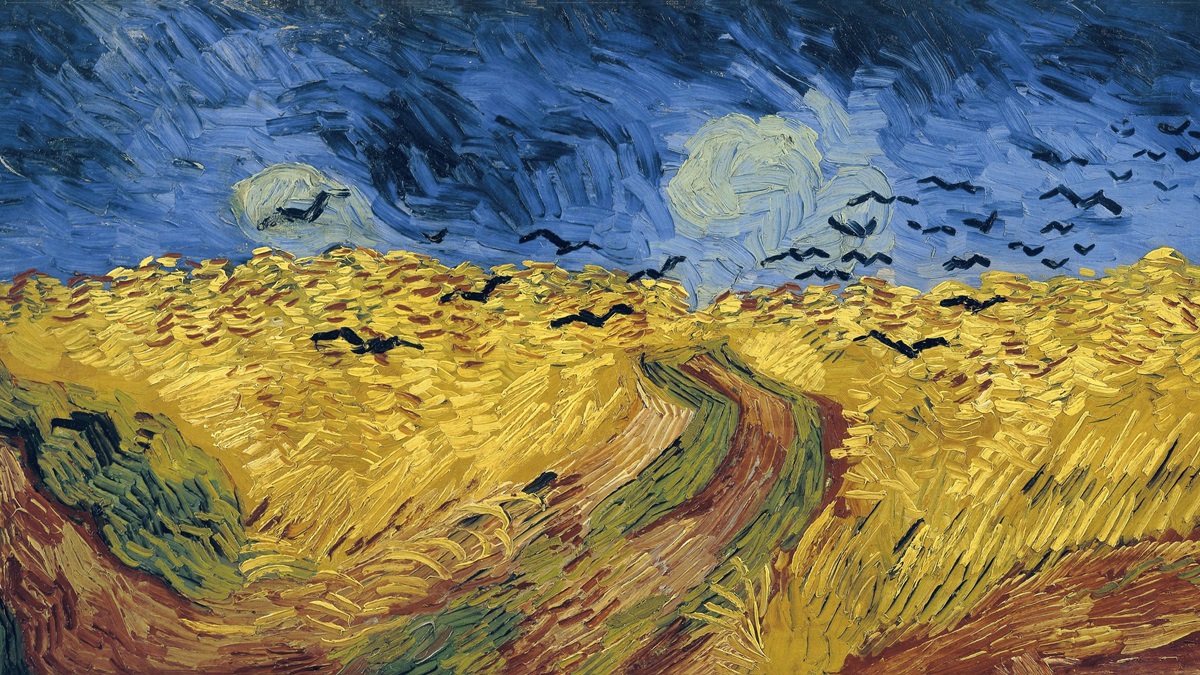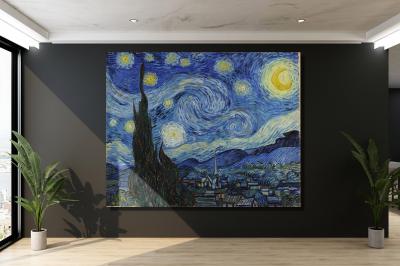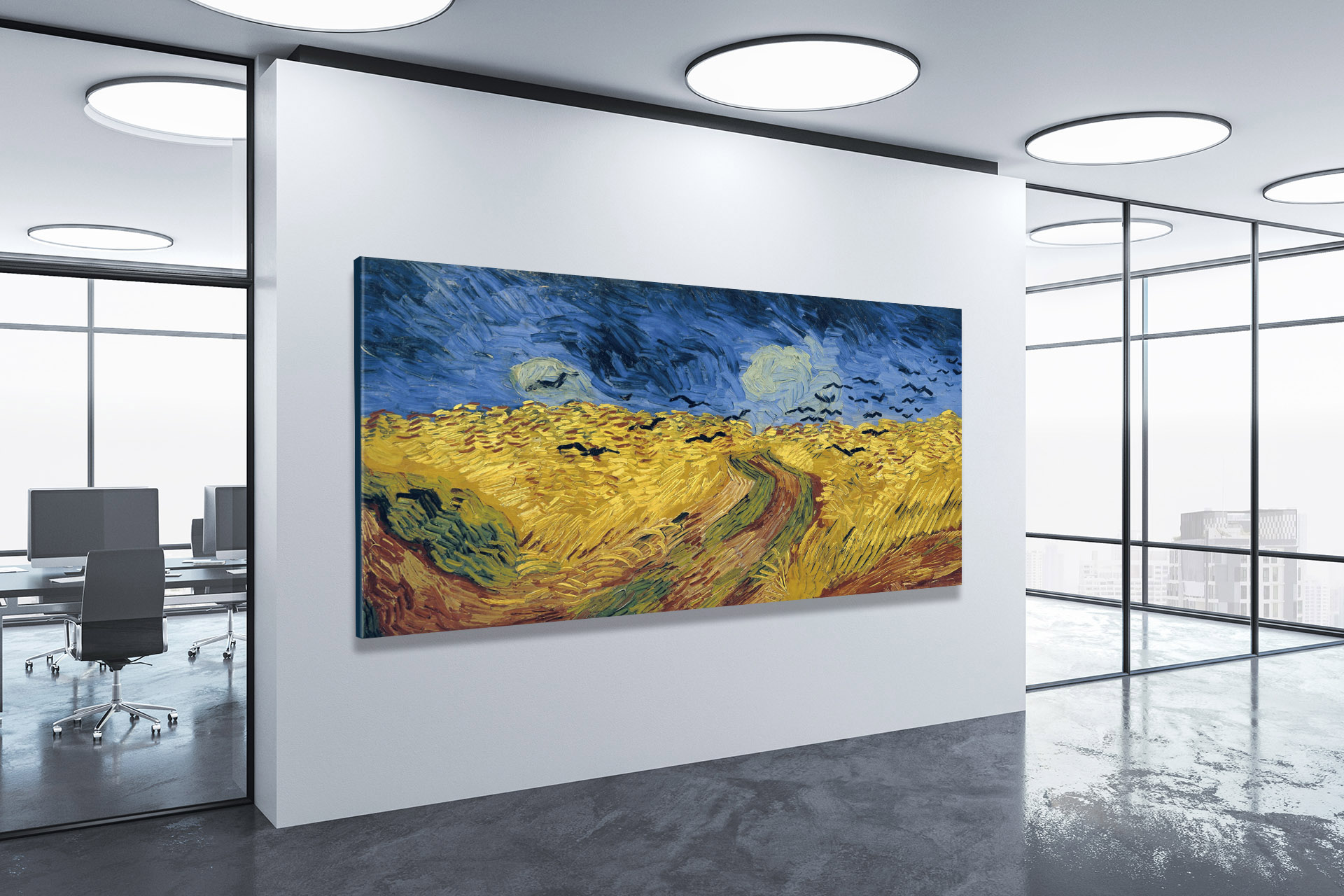Wheat field with Crows
By Vincent van Gogh, 1890
Vincent van Gogh’s “Wheat Field with Crows”: A Masterpiece of Despair and Beauty
Vincent van Gogh, one of the most celebrated and enigmatic artists in the history of art, left behind a legacy of emotional and powerful works that continue to captivate art lovers and scholars alike. Among his extensive portfolio, “Wheat Field with Crows” stands as a testament to his genius and the tumultuous inner world that fueled his artistic expression. Painted in 1890, this masterpiece is a mesmerizing blend of despair and beauty, revealing the complexity of van Gogh’s psyche and his unparalleled artistic talent. In this in-depth exploration, we will delve into the layers of emotion, symbolism, artistic mastery, technical challenges, the significance of its location, and an overview of the artist himself that make “Wheat Field with Crows” a timeless and hauntingly evocative work.
The Painting’s Context and Location
“Wheat Field with Crows” occupies a unique place in van Gogh’s oeuvre, as it was created during a particularly tumultuous and poignant period in his life while he resided in the picturesque town of Arles in the sun-soaked region of southern France. Arles, with its vibrant colors, picturesque landscapes, and vibrant atmosphere, was an ideal location for van Gogh to seek solace and inspiration. However, his time in Arles was marked by bouts of mental illness, loneliness, and personal turmoil. “Wheat Field with Crows” was executed shortly before his tragic death in 1890, making it a poignant reflection of his inner turmoil and the challenges he faced during his artistic journey.
“Wheat Field with Crows” Large Canvas Prints from WhiteClouds
The Aesthetic Beauty and Technical Challenges
At first glance, “Wheat Field with Crows” presents itself as a serene and picturesque countryside scene. Van Gogh’s signature style comes alive in this painting, with vivid, swirling colors and thick, impasto brushwork infusing life into the canvas. The sky is a mesmerizing blend of tumultuous blues and whites, capturing the ever-changing weather of the region. The golden wheat fields below ripple with vitality, each brushstroke suggesting the gentle sway of the stalks in the wind. Van Gogh’s mastery over color and texture is on full display, creating an overall effect that is both captivating and emotionally charged.
However, achieving this effect was not without technical challenges. Van Gogh’s use of impasto, a technique involving the application of thick, textured paint, required immense skill and precision. Layer upon layer of paint was meticulously applied to create the rich texture and depth that defines the painting. The use of bold, contrasting colors, particularly the radiant yellows and deep blues, was a deliberate choice to convey the emotional intensity of the scene. Van Gogh’s dedication to his craft is evident in the painstaking attention to detail, as he sought to capture the essence of the landscape and the emotions it evoked.
The Symbolism
Beneath the surface beauty of “Wheat Field with Crows” lies a wealth of symbolism that adds depth and complexity to the painting. The most striking element is, of course, the crows. A flock of dark, foreboding birds fills the sky, their presence looming ominously. For many art historians and enthusiasts, these crows represent van Gogh’s inner torment and despair, serving as harbingers of death and the darkness that plagued his thoughts.
The wheat field itself, with its vibrant yellow and orange hues, stands in stark contrast to the brooding sky above. It is seen as a symbol of life and vitality, representing van Gogh’s connection to the natural world and his desire to find solace in its beauty. This contrast creates visual tension that mirrors the emotional turmoil within van Gogh’s mind, as if the vibrant wheat is struggling to break free from the ominous presence of the crows.
The path that winds through the wheat field and leads into the distance is another significant element of the painting’s symbolism. It can be interpreted as a metaphor for van Gogh’s own tumultuous life journey, filled with challenges and uncertainties. The path invites viewers to embark on their own introspective journey, contemplating the complexities of the human experience.
Vincent van Gogh: The Tormented Genius
Vincent van Gogh’s life was a tumultuous journey marked by personal struggles, artistic passion, and creative genius. Born in the Netherlands in 1853, he initially pursued a career in art at a relatively late age. His artistic journey took him from the Netherlands to Paris and, ultimately, to the sun-drenched landscapes of southern France. Throughout his career, van Gogh grappled with mental illness, including depression and episodes of psychosis, which deeply influenced his work.
Despite the challenges he faced, van Gogh’s art evolved dramatically over the years. His early works were characterized by dark, somber colors and a focus on the lives of peasants. However, his time in Arles, where “Wheat Field with Crows” was created, marked a transformative period in his artistic style. He began to experiment with bold, vibrant colors and thick impasto brushwork, resulting in the distinctive style that has come to define his later works.
Van Gogh’s passion for art was matched only by his fervent dedication to his craft. He produced over 2,000 artworks during his brief career, including iconic pieces such as “Starry Night” and “Sunflowers.” Tragically, van Gogh’s struggles with mental health eventually led to his untimely death by suicide in 1890 at the age of 37.
 Wheat Field with Crows by Vincent van Gogh
Wheat Field with Crows by Vincent van Gogh
Conclusion
Vincent van Gogh’s “Wheat Field with Crows” is a masterpiece that continues to intrigue and captivate audiences worldwide. It is not merely a landscape; it is a window into the soul of a tormented genius. This painting’s rich symbolism, vibrant colors, and the haunting presence of the crows all contribute to its enduring appeal. It stands as a confirmation to the power of art to convey the depth of human emotion and serves as a poignant reminder of the artist’s tumultuous journey. “Wheat Field with Crows” invites us to explore the complexities of life, death, beauty, and despair, making it a timeless and evocative work that will forever resonate with those who gaze upon it. The technical challenges van Gogh overcame and the significance of its location in Arles further enhance our understanding of this extraordinary masterpiece, while a brief exploration of the artist himself sheds light on the passionate and tormented soul behind the canvas.
Frequently Asked Questions About “Wheat Field with Crows”
What is the meaning or symbolism behind the crows in “Wheat Field with Crows”? The crows in the painting are often interpreted as a symbol of death, darkness, and van Gogh’s inner turmoil. They can be seen as harbingers of his impending tragic end, reflecting his emotional struggles and mental state at the time.
Is “Wheat Field with Crows” considered van Gogh’s last painting? While it is often referred to as one of van Gogh’s last works, it may not be his very last painting. It was created shortly before his death, and the exact chronology of his final artworks is a subject of some debate among art historians.
How did van Gogh create the thick and textured impasto effect in this painting? Van Gogh achieved the impasto effect by applying thick layers of oil paint directly onto the canvas with a palette knife or brush. This technique added texture and depth to the painting, creating a three-dimensional quality.
What inspired van Gogh to paint this particular landscape? Van Gogh found inspiration in the beautiful landscapes of Arles, where he lived at the time. He was drawn to the golden wheat fields, which he saw as a representation of life and vitality amid his personal struggles.
What is the significance of the location of the painting, specifically Arles, in van Gogh’s life and work? Arles played a crucial role in van Gogh’s artistic journey. The vibrant colors and natural beauty of the region greatly influenced his work during his time there, and “Wheat Field with Crows” is a reflection of this period in his life.
Can you explain the emotional or psychological state of van Gogh at the time he painted this piece? Van Gogh was in a fragile emotional state during the creation of this painting. He grappled with mental illness, including depression and psychotic episodes, which deeply affected his perception of the world and his art.
Are there any alternative interpretations of the painting’s symbolism apart from the crows and the wheat field? Some art historians have suggested that the path winding through the wheat field may symbolize a spiritual or emotional journey, while others have focused on the contrast between light and dark as representing hope and despair.
What techniques or artistic innovations did van Gogh employ in “Wheat Field with Crows” compared to his earlier works? In “Wheat Field with Crows,” van Gogh used bolder and more vibrant colors, as well as the impasto technique, which he employed more extensively than in his earlier works. This gave the painting a distinctive and textured appearance.
How has the painting been preserved and displayed throughout its history? The painting has been housed in various collections and museums over the years, and it has been meticulously preserved to ensure its longevity. It has been exhibited in prominent art exhibitions around the world.
Are there any notable anecdotes or stories related to the creation of this artwork? While there are no specific anecdotes directly tied to the creation of “Wheat Field with Crows,” van Gogh’s life and struggles are filled with numerous compelling stories that provide context to his work.
What materials and colors did van Gogh use in “Wheat Field with Crows”? Van Gogh primarily used oil paints on canvas for this painting. His color palette included bold blues, radiant yellows, and contrasting tones to convey the emotional depth of the scene.
How has the critical reception and interpretation of the painting evolved over time? The critical reception of “Wheat Field with Crows” has evolved over time, with interpretations ranging from a dark and foreboding depiction to a reflection of van Gogh’s inner turmoil. It continues to be analyzed and appreciated in new ways.
Is “Wheat Field with Crows” part of any prominent art collections or exhibitions? Yes, the painting has been part of various art collections and exhibitions worldwide. It is often a centerpiece in exhibitions dedicated to van Gogh’s work and his impact on art history.
Are there any controversies or debates surrounding the authenticity or history of “Wheat Field with Crows”? There are no major controversies or debates regarding the authenticity of the painting. Its provenance and history have been well-documented and are widely accepted.
What is the current location or ownership of the painting? The painting is currently housed in the Van Gogh Museum in Amsterdam, where it is a part of their extensive collection of van Gogh’s works.
Has “Wheat Field with Crows” ever been subjected to scientific analysis or restoration? Like many valuable artworks, the painting has undergone scientific analysis and restoration to preserve its condition. These efforts have helped maintain the integrity of the artwork.
How does this artwork fit into the broader context of van Gogh’s body of work and artistic development? “Wheat Field with Crows” marks a significant stage in van Gogh’s artistic evolution, showcasing his distinctive style and emotional intensity. It is often seen as a culmination of his career and a reflection of his inner struggles.
What is the enduring appeal and significance of “Wheat Field with Crows” in the world of art and culture? The painting’s enduring appeal lies in its emotional depth, artistic innovation, and the mystique surrounding van Gogh’s life. It continues to inspire and provoke contemplation among art enthusiasts and the general public.
Other Articles on Vincent van Gogh Paintings
At Eternities Gate by Vincent Van Gogh, 1890
Blossoming Almond Tree by Vincent Van Gogh, 1890
Cafe Terrace at Night by Vincent Van Gogh, 1888
Daubigneys Garden by Vincent Van Gogh, 1890
Green Wheat Field with Cypress by Vincent Van Gogh, 1889
Houses at Auvers by Vincent Van Gogh, 1890
Irises by Vincent Van Gogh, 1889
Night Café by Vincent Van Gogh, 1888
Portrait of Dr. Gachet by Vincent Van Gogh, 1890
Red Vineyards by Vincent Van Gogh, 1888
Road with Cypress and Star by Vincent Van Gogh, 1890
Starry Night by Vincent Van Gogh, 1889
Starry Night over the Rhone by Vincent Van Gogh, 1888
Sunflowers by Vincent Van Gogh, 1887
The Bedroom by Vincent Van Gogh, 1888
The Church at Aurers by Vincent Van Gogh, 1890
The Garden of the Asylum by Vincent Van Gogh, 1889
The Mulberry Tree by Vincent Van Gogh, 1889
The Potato Eaters by Vincent Van Gogh, 1885
The Yellow House by Vincent Van Gogh, 1888
Tree Roots by Vincent Van Gogh, 1890
Van Gogh Self Portrait by Vincent Van Gogh, 1887
Vase with Red Poppies by Vincent Van Gogh, 1886
View of Arles by Vincent Van Gogh, 1889
Wheat Field with Crows by Vincent Van Gogh, 1890
Wheat Field with Cypresses by Vincent Van Gogh, 1889
More WhiteClouds Videos
Contact us today to learn more about our 3D services and how we can help you achieve your goals.

